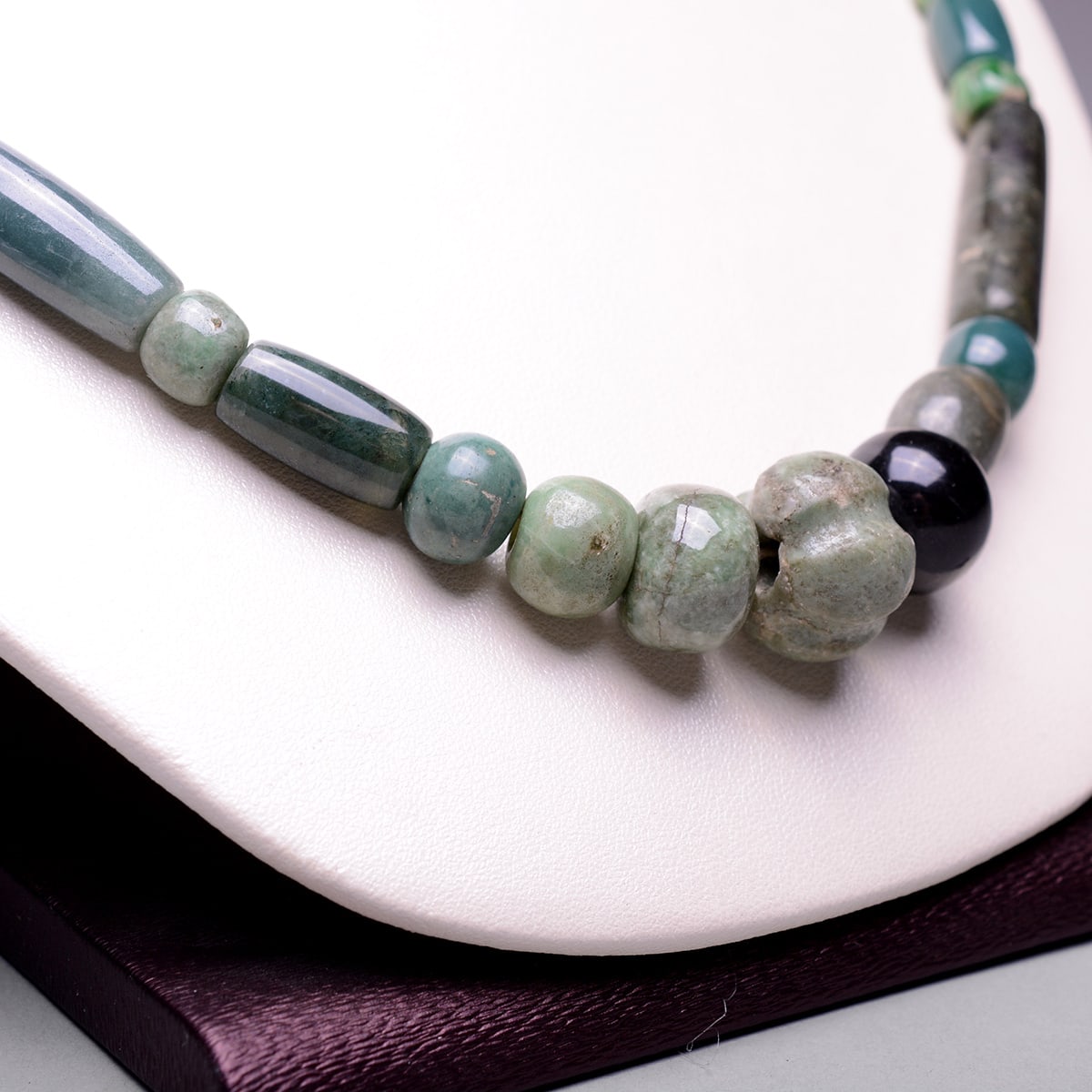Mayan Jade Bead Necklace, 300 CE - 900 CE
Jade
FJ.7308
Further images
The Classic Maya period was an age of profound intellectual and artistic achievements, when the Maya built monumental pyramids and magnificent urban centers in homage to their gods. At a...
The Classic Maya period was an age of profound intellectual and artistic achievements, when the Maya built monumental pyramids and magnificent urban centers in homage to their gods. At a time when the Western world languished after the fall of the Roman Empire, the New World experienced an age of imperial grandeur, when great city-states like Tikal and Copán proclaimed Mayan hegemony over the emerald forests of Mexico and Guatemala. Theirs was a sophisticated but startlingly brutal civilization— wars were waged not for land or prestige, but for blood, for slaves sacrificed atop the great pyramids to appease the god’s insatiable lust for human flesh. The Mayan world was an arcane realm where the earth was contiguous with the heavens and the underworld. It was a society infused with spiritualism, a society that reflected both the majesty and savagery of the rain forests. Like the ancient societies of the Mediterranean, ceramic forms were vital to the Mayan economy and traded alongside coveted resources such as jade, obsidian, flint, and shells.
The Maya believed the universe was divided into three parts: the Over world (heaven), the Middle world (the world of humankind), and the Underworld (hell). All three were considered interconnected and accessible through "doorways", or through Shamanic ritual. It was believed the Underworld could be entered through a cave or through bodies of standing water, such as a lake or ocean. To comprehend the nature of these three worlds and the beings that inhabit them was important to daily life of Maya society.
Mayan art was composed of a complex symbolic language with deeply important social functions. Mainly commissioned by kings and other elite figures, works of Mayan art fulfilled both political and social purposes. Because the art functioned as a type of language, to be understood by the entire population, a certain consistency in subject matter and its portrayal was necessary. Whether on a cylinder vessel or a great mural, Maya art essentially depicts ritual. The impressive Maya ceremonies, recorded for posterity in their art, were crucial events in the lives of the kings, and consequently important to society as a whole. In Maya believe, an actual ritual ceremony is directly connected with the art which represents it; both conceived of as a power process that transformed spiritual beings into corporeal beings on the human level, and allowed people and objects to become the sacred beings they represented.
In the 9th and 10th centuries AD, the productivity of the southern regions went into decline for reasons that are still uncertain (although ecological causes are the likeliest option), although the northern areas continued to flourish on a reduced scale until the arrival of European forces and the subsequent decimation of Native American cultures across both continents. What is left, however – particularly dating to the Classic Period – includes art and other achievements that many consider to be the most refined and beautiful of the ancient New World. Stucco, mural painting (notably with the use of “Maya Blue”, the secret of which has been lost since the 16th century) and sculpture were all of an astounding quality and naturalism, with some sophisticated expressionistic tendencies.
The Maya believed the universe was divided into three parts: the Over world (heaven), the Middle world (the world of humankind), and the Underworld (hell). All three were considered interconnected and accessible through "doorways", or through Shamanic ritual. It was believed the Underworld could be entered through a cave or through bodies of standing water, such as a lake or ocean. To comprehend the nature of these three worlds and the beings that inhabit them was important to daily life of Maya society.
Mayan art was composed of a complex symbolic language with deeply important social functions. Mainly commissioned by kings and other elite figures, works of Mayan art fulfilled both political and social purposes. Because the art functioned as a type of language, to be understood by the entire population, a certain consistency in subject matter and its portrayal was necessary. Whether on a cylinder vessel or a great mural, Maya art essentially depicts ritual. The impressive Maya ceremonies, recorded for posterity in their art, were crucial events in the lives of the kings, and consequently important to society as a whole. In Maya believe, an actual ritual ceremony is directly connected with the art which represents it; both conceived of as a power process that transformed spiritual beings into corporeal beings on the human level, and allowed people and objects to become the sacred beings they represented.
In the 9th and 10th centuries AD, the productivity of the southern regions went into decline for reasons that are still uncertain (although ecological causes are the likeliest option), although the northern areas continued to flourish on a reduced scale until the arrival of European forces and the subsequent decimation of Native American cultures across both continents. What is left, however – particularly dating to the Classic Period – includes art and other achievements that many consider to be the most refined and beautiful of the ancient New World. Stucco, mural painting (notably with the use of “Maya Blue”, the secret of which has been lost since the 16th century) and sculpture were all of an astounding quality and naturalism, with some sophisticated expressionistic tendencies.











